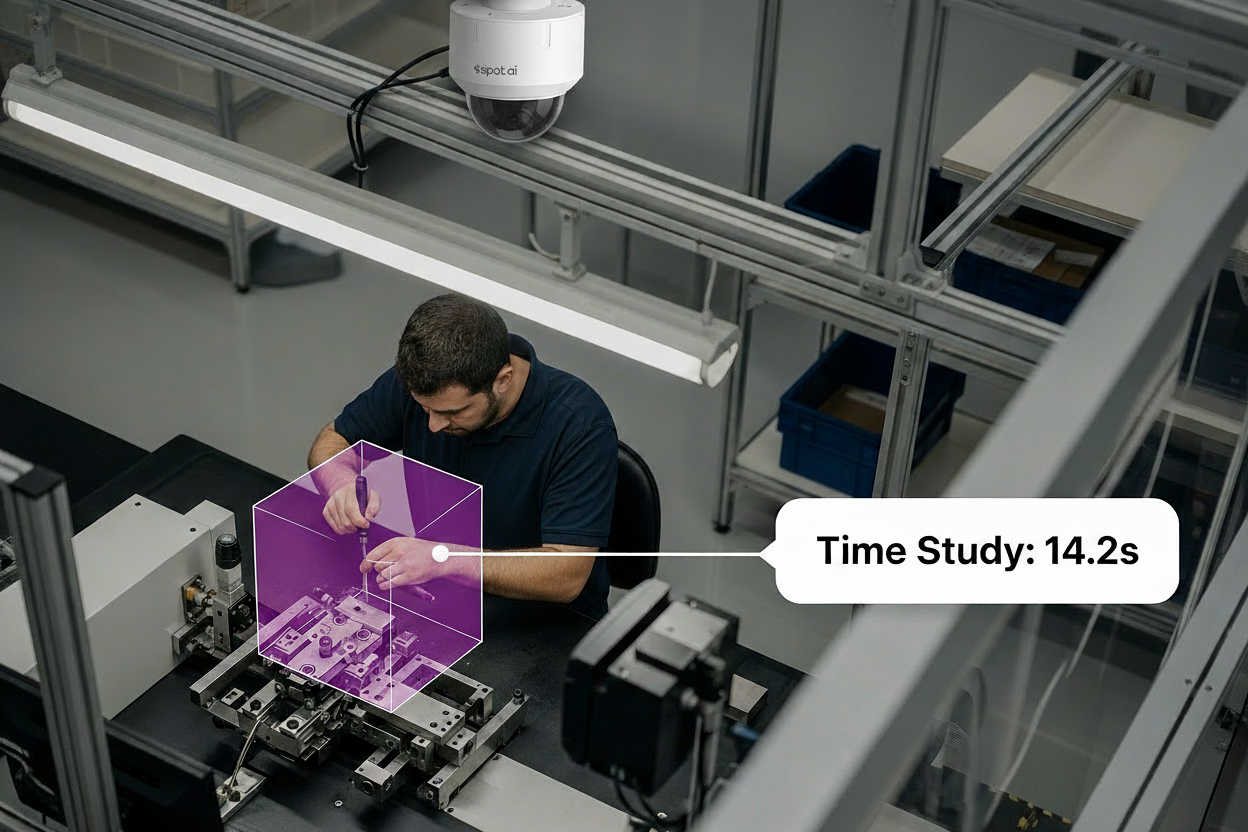Manufacturing teams implementing Six Sigma projects often have access to large amounts of data but lack real-time visibility into actual process performance. While spreadsheets capture defect rates and cycle times, they miss the critical visual context that reveals why problems occur and whether improvements are sustained. Video analytics bridges this gap, transforming existing security cameras into effective process monitoring tools that support every phase of DMAIC (Define, Measure, Analyze, Improve, Control) methodology.
Integrating video analytics with Six Sigma supports a strategic shift from reactive problem-solving to forward-looking process optimization. Instead of discovering quality issues after products fail inspection, teams can now detect process deviations as they happen and intervene to address issues before they lead to defects.
Understanding the basics: DMAIC meets modern video intelligence
To set the context, several key terms bridge traditional quality management with newer technology:
DMAIC (Define, Measure, Analyze, Improve, Control) represents the structured problem-solving methodology at the heart of Six Sigma, providing a systematic approach to process improvement through five distinct phases.
Video analytics refers to AI-powered software that automatically analyzes video streams to detect specific events, behaviors, or conditions without human monitoring, turning passive cameras into active process monitors.
Computer vision encompasses the underlying technology that enables machines to interpret and understand visual information from cameras, identifying patterns and anomalies that human observers might miss.
Edge computing allows video processing to occur directly at the camera or facility level, ensuring low-latency response times critical for real-time quality control without depending on cloud connectivity.
Standard Operating Procedures (SOPs) are the documented step-by-step instructions that ensure consistent process execution, which video analytics can now monitor and verify automatically across all shifts and locations.
The hidden cost of manual process monitoring in Six Sigma projects
Traditional Six Sigma implementations rely heavily on manual data collection and periodic observations that capture only fragments of actual process performance. Manufacturing teams conducting Gemba walks (where management observes processes on the floor) might spend hours observing production lines, yet miss critical events that occur between visits. This snapshot approach to process monitoring creates substantial blind spots that undermine improvement efforts.
Root cause analysis for a quality issue from the previous week can be difficult. Without video evidence, teams may interview operators who cannot recall specific details, examine incomplete documentation, or make educated guesses about the event. This approach can extend DMAIC cycles from weeks to months, delaying progress and allowing problems to persist.
The inability to verify SOP compliance at scale presents another major hurdle. While Six Sigma projects often focus on standardizing best practices, ensuring consistent execution across all shifts and locations remains difficult to ensure without continuous monitoring. Night shift variations, temporary worker deviations, and gradual process drift all contribute to quality issues that periodic audits often miss.
Hidden process waste exacerbates these issues. Minor inefficiencies in material handling, unnecessary motion, and waiting time accumulate into major productivity losses. Yet without continuous visual monitoring, these forms of waste remain invisible to traditional Six Sigma tools. A forklift making extra trips, operators walking excessive distances, or materials sitting idle between processes—all represent improvement opportunities that manual observation methods consistently miss.
How video analytics enhances each phase of DMAIC
Define phase: Establishing visual baselines and project scope
Video analytics transforms the Define phase by providing visual evidence of current-state processes that supplements traditional metrics. Instead of relying solely on reported defect rates or cycle times, teams can review actual footage to understand the true nature of problems and establish more accurate project scopes.
Spot AI's natural language search capabilities enable teams to quickly locate specific events or conditions across weeks of footage. Searching for "improper tool placement" or "crowding at workstation 3" surfaces relevant clips that help define project boundaries and priorities. This visual context ensures DMAIC projects target root causes rather than symptoms.
The platform's ability to analyze patterns across multiple cameras and locations also helps identify systemic issues that single-point observations miss. When defining a project to reduce changeover times, teams can compare procedures across different shifts and lines, identifying best practices that already exist within the organization.
Measure phase: Continuous data collection replacing periodic sampling
Traditional Six Sigma measurement relies on periodic sampling that captures a small fraction of actual process activity. Video analytics allows for total inspection by monitoring every cycle, every changeover, and every product movement. This complete data collection improves the accuracy and reliability of baseline measurements.
Alerts for process deviations offer real-time feedback on current performance levels. When operators skip steps in a changeover procedure or materials arrive late to a workstation, the system captures these events automatically. This continuous measurement eliminates the sampling bias that often skews Six Sigma calculations.
Historical data accessibility refines measurement accuracy. Instead of estimating cycle times based on stopwatch studies, teams can analyze thousands of actual cycles to establish true baseline performance. Variations between operators, shifts, and product types become clearly visible, enabling more precise problem definition and goal setting.
Analyze phase: Visual root cause analysis with AI-powered insights
The Analyze phase benefits from video analytics' ability to correlate visual events with quality outcomes. When defect rates spike, teams can review footage from the corresponding time period to identify what changed. This visual root cause analysis shortens investigation time compared to traditional methods.
Pattern recognition capabilities help teams correlate visual events with quality outcomes. By analyzing trends in alerts—such as SOP deviations at certain workstations or crowding in specific areas—teams can uncover process variables that impact quality. These insights often remain hidden in traditional data analysis.
Multi-angle analysis delivers a complete understanding of complex problems. By synchronizing footage from multiple cameras, teams can trace material flow, identify bottlenecks, and understand how upstream variations impact downstream quality. This holistic view enables more effective root cause identification and solution development.
Improve phase: Real-time validation of process changes
Video analytics accelerates the Improve phase by providing real-time feedback on implemented changes. When teams modify a changeover procedure or adjust workstation layouts, they can monitor the impact in real-time rather than waiting weeks for statistical validation.
For example, teams can use video to test different sequences, quickly see the time impact, and refine procedures based on visual evidence. This rapid experimentation cycle helps compress improvement implementation timelines.
Automated compliance monitoring helps ensure improvements are sustained. When new SOPs are implemented, video analytics helps verify that all operators follow the updated procedures consistently. Deviations trigger timely alerts, enabling quick correction before bad habits form. This timely reinforcement increases the success rate of process changes.
Control phase: Sustained monitoring to guard against regression
In the Control phase, progress can degrade once project teams move on. Video analytics offers the ongoing monitoring necessary to sustain gains long term, automatically detecting when processes drift from established standards.
Automated control charts powered by visual data provide early warning of process degradation. When cycle times begin creeping up or safety procedures start being skipped, the system alerts process owners in a timely manner. This anticipatory approach helps guard against gradual regression that undermines many Six Sigma initiatives.
Performance dashboards accessible to all stakeholders maintain visibility and accountability. Operators see their own compliance scores, supervisors monitor shift performance, and executives track improvement sustainability across facilities. This transparency fosters a commitment to ongoing optimization that extends beyond individual projects.
Measuring success: Key performance improvements from video-enhanced DMAIC
Manufacturing organizations implementing video analytics within their Six Sigma programs report measurable progress across multiple dimensions. These gains validate the investment in visual technology and demonstrate the positive effect of combining traditional methodologies with new analytics.
Quality improvements
For example, automotive leaders use AI-powered video analytics to monitor SOP adherence in assembly processes. The technology can detect deviations from standard operating procedures and provide real-time feedback to operators, helping to address process-related issues early.
When video analytics enables on-the-spot detection at individual workstations, the feedback loop allows operators to correct issues without delay. This helps keep defective products from moving to subsequent operations where rework becomes more complex and costly, which can lower scrap and rework rates.
Efficiency gains
Production efficiency can also increase. By implementing video-enhanced Six Sigma projects, facilities gain better visibility into equipment performance, which supports faster problem resolution and better machine utilization.
These time savings can accumulate from faster changeovers, reduced material search time, and quicker problem diagnosis when issues arise, contributing to overall operational efficiency.
Safety and compliance benefits
Video analytics can also support safety goals by providing timely hazard detection and behavioral alerts. This capability stems from intervention opportunities—when someone enters a restricted area or skips PPE requirements, supervisors can receive real-time notifications that enable timely correction.
Compliance documentation, traditionally a time-consuming burden, becomes largely automated. Video analytics generates audit-ready reports showing SOP adherence rates, safety protocol compliance, and process consistency across all operations. This automation frees professionals to focus on driving optimizations rather than creating reports.
Implementation best practices for video-enhanced Six Sigma
Starting with high-impact pilot projects
Successful implementations begin with carefully selected pilot projects that demonstrate clear value while building organizational confidence. Focus initial deployments on high-frequency processes with known variability, such as changeover procedures or safety-critical operations where visual monitoring provides clear benefits.
A phased approach reduces risk while allowing teams to refine their integration of video analytics with existing Six Sigma methodologies. Start with a single production line or work cell, validate the benefits, then expand systematically based on lessons learned.
Building cross-functional support
Change management remains critical when introducing video monitoring to manufacturing environments. Address workforce concerns proactively by emphasizing that video analytics aims to refine processes. Share success stories where visual insights helped eliminate dangerous tasks or simplified difficult procedures.
Involve frontline operators in system design and optimization. Their practical knowledge ensures video analytics captures genuinely useful information while building buy-in for the technology. When operators see the system helping them work more safely and efficiently, advocacy and adoption are higher.
Ensuring technical integration success
Technical architecture decisions greatly impact implementation success. Edge computing capabilities prove essential for manufacturing applications requiring real-time response. Processing video locally eliminates dependence on network connectivity while ensuring low-latency responses for critical quality or safety issues.
Integration with existing manufacturing systems maximizes value from video analytics investments. Connect visual findings with MES platforms, quality management systems, and ERP applications to create a complete operational overview. This integration enables automated workflows where visual events trigger appropriate system responses.
Measuring and communicating ROI
Establish clear baseline metrics before implementation to demonstrate improvement accurately. Document current defect rates, cycle times, safety incidents, and compliance costs to enable clear before-and-after comparisons.
Track both hard savings from reduced defects and soft benefits like faster problem resolution and improved employee engagement. Many organizations find that safety enhancements and compliance automation alone deliver substantial value, with efficiency gains offering additional returns.
Accelerate your Six Sigma initiatives with visual intelligence
Running Six Sigma projects with incomplete data and delayed findings can limit their effectiveness. Video analytics delivers the ongoing visibility and rapid feedback necessary to accelerate DMAIC cycles, sustain progress, and achieve measurable performance gains.
For professionals seeking to establish forward-looking quality management systems, video analytics offers a strategic pathway from reactive problem resolution to systematic process optimization. By turning existing cameras into intelligent process monitors, teams gain the visual evidence needed to drive faster, more effective optimizations.
See how Spot AI’s video AI platform can accelerate your Six Sigma projects. Request a demo to experience real-time process monitoring and visual analytics in action.
Frequently asked questions
What are the best practices for process improvement in manufacturing?
Best practices for manufacturing process improvement include establishing clear baseline measurements, involving frontline workers in solution development, and implementing continuous monitoring systems for sustained gains. Video analytics supports these practices by offering complete visual data for accurate baselines, capturing operator knowledge through recorded process variations, and allowing 24/7 automated monitoring that helps confirm that progress persists long after project completion.
How can video analytics enhance quality assurance?
Video analytics strengthens quality assurance by enabling total process inspection versus traditional sampling methods, delivering timely alerts for process deviations, and creating searchable visual records for root cause analysis. Instead of focusing on product-level defects, AI-powered systems monitor the production process itself. They can identify operational patterns correlated with quality issues and automatically document compliance with standard procedures across all shifts and locations, helping teams prevent defects from occurring in the first place.
What role does AI play in preventing manufacturing defects?
AI serves as the engine that converts raw video feeds into actionable process insights. Rather than inspecting finished products, machine learning algorithms are trained to understand correct operational procedures. They can identify when a process deviates from the standard—such as a missed step in an assembly sequence or incorrect tool usage—and alert teams in real time. This proactive approach allows operators to correct issues before they lead to defects, shifting the focus from detection to prevention.
What are the benefits of reducing production downtime?
Reducing production downtime delivers direct financial benefits through increased output capacity, lower per-unit production costs, and improved delivery performance. Video analytics contributes to downtime reduction by accelerating problem diagnosis when issues occur and minimizing quality-related stops through early detection of process deviations. Organizations report a substantial reduction in unplanned downtime after implementing video-enhanced monitoring systems (Source: IndustryWeek).
How can AI video analytics help identify the 8 wastes of Lean?
Video analytics provides the visual proof needed to identify the 8 wastes of Lean. For example, it can automatically track unnecessary motion by analyzing operator paths, quantify waiting by monitoring idle time at workstations, and highlight inefficient transportation by reviewing forklift routes. This data allows teams to target specific forms of waste that are often missed by manual observation.
About the author
Dunchadhn Lyons leads Spot AI’s AI Engineering team, building real-time video AI for operations, safety, and security—turning video data into alerts, insights, and workflows that cut incidents and boost productivity.

























.png)
.png)
.png)